Are Early or Late Maturers Likely to Be Fitter in the General Population?
Abstract
1. Introduction
2. Materials and Methods
2.1. Experimental Approach to the Problem
2.2. Participants
2.3. Procedures
2.3.1. Anthropometric Measurements
2.3.2. Sprint Speed
2.3.3. Jump Performance
2.3.4. Handgrip Strength
2.3.5. Illinois Change of Direction Test
2.4. Statistical Analyses
3. Results
3.1. Sprint Speed
3.2. Horizontal Jumping
3.3. Vertical Jumping
3.4. Strength and Change of Direction Tests
4. Discussion
5. Conclusions
Author Contributions
Funding
Institutional Review Board Statement
Informed Consent Statement
Data Availability Statement
Acknowledgments
Conflicts of Interest
References
- Granacher, U.; Borde, R. Effects of Sport-Specific Training during the Early Stages of Long-Term Athlete Development on Physical Fitness, Body Composition, Cognitive, and Academic Performances. Front. Physiol. 2017, 8, 810. [Google Scholar] [CrossRef]
- Wormhoudt, R.; Savelsbergh, G.J.P.; Teunissen, J.W.; Davids, K. The Athletic Skills Model; Routledge: London, UK, 2018. [Google Scholar]
- Abbott, A.; Button, C.; Pepping, G.J.; Collins, D. Unnatural selection: Talent identification and development in sport. Nonlinear Dyn. Psychol. Life Sci. 2005, 9, 61–88. [Google Scholar]
- Katzmarzyk, P.T.; Malina, R.M.; Beunen, G.P. The contribution of biological maturation to the strength and motor fitness of children. Ann. Hum. Biol. 1997, 24, 493–505. [Google Scholar] [CrossRef] [PubMed]
- Lovell, R.; Towlson, C.; Parkin, G.; Portas, M.; Vaeyens, R.; Cobley, S. Soccer Player Characteristics in English Lower-League Development Programmes: The Relationships between Relative Age, Maturation, Anthropometry and Physical Fitness. PLoS ONE 2015, 10, e0137238. [Google Scholar] [CrossRef] [PubMed]
- Vandendriessche, J.B.; Vaeyens, R.; Vandorpe, B.; Lenoir, M.; Lefevre, J.; Philippaerts, R.M. Biological maturation, morphology, fitness, and motor coordination as part of a selection strategy in the search for international youth soccer players (age 15–16 years). J. Sports Sci. 2012, 30, 1695–1703. [Google Scholar] [CrossRef] [PubMed]
- Meyers, R.W.; Oliver, J.L.; Hughes, M.G.; Lloyd, R.S.; Cronin, J.B. Influence of Age, Maturity, and Body Size on the Spatiotemporal Determinants of Maximal Sprint Speed in Boys. J. Strength Cond. Res. 2017, 31, 1009–1016. [Google Scholar] [CrossRef] [PubMed]
- Pearson, D.; Naughton, G.; Torode, M. Predictability of physiological testing and the role of maturation in talent identification for adolescent team sports. J. Sci. Med. Sport 2006, 9, 277–287. [Google Scholar] [CrossRef] [PubMed]
- Cobley, S.P.; Baker, J.; Wattie, N.; McKenna, J. Annual age-grouping and athlete development. Sports Med. Open 2009, 39, 235–256. [Google Scholar] [CrossRef]
- Torres-Unda, J.; Zarrazquin, I.; Gil, J.; Ruiz, F.; Irazusta, A.; Kortajarena, M.; Seco, J.; Irazusta, J. Anthropometric, physiological and maturational characteristics in selected elite and non-elite male adolescent basketball players. J. Sports Sci. 2013, 31, 196–203. [Google Scholar] [CrossRef]
- Arede, J.; Ferreira, A.P.; Gonzalo-Skok, O.; Leite, N. Maturational Development as Key Aspect in Physical Performance and National Team Selection in Elite Male Basketball Players. Int. J. Sports Physiol. Perform. 2018, 20, 1–24. [Google Scholar]
- Te Wierike, S.C.M.; Elferink-Gemser, M.T.; Tromp, E.J.; Vaeyens, R.; Visscher, C. Role of maturity timing in selection procedures and in the specialisation of playing positions in youth basketball. J. Sports Sci. 2015, 33, 337–345. [Google Scholar] [CrossRef] [PubMed]
- Lloyd, R.S.; Oliver, J.L.; Radnor, J.M.; Rhodes, B.C.; Faigenbaum, A.D.; Myer, G.D. Relationships between functional movement screen scores, maturation and physical performance in young soccer players. J. Sports Sci. 2015, 33, 11–19. [Google Scholar] [CrossRef]
- Wright, M.D.; Chesterton, P. Functional Movement ScreenTM total score does not present a gestalt measure of movement quality in youth athletes. J. Sports Sci. 2019, 37, 1393–1402. [Google Scholar] [CrossRef] [PubMed]
- Towlson, C.; Cobley, S.; Parkin, G.; Lovell, R. When does the influence of maturation on anthropometric and physical fitness characteristics increase and subside? Scand. J. Med. Sci. Sports 2018, 28, 1946–1955. [Google Scholar] [CrossRef]
- Lloyd, R.; Faigenbaum, A.; Stone, M.; Oliver, J.; Jeffreys, I.; Moody, J.; Brewer, C.; Pierce, K.; McCambridge, T.; Howard, R.; et al. Position statement on youth resistance training: The 2014 International Consensus. Br. J. Sports Med. 2014, 48, 498–505. [Google Scholar] [CrossRef] [PubMed]
- Moore, S.A.; McKay, H.A.; Macdonald, H.; Nettlefold, L.; Baxter-Jones, A.D.; Cameron, N.; Brasher, P.M. Enhancing a somatic maturity prediction model. Med. Sci. Sports Exerc. 2015, 47, 1755–1764. [Google Scholar] [CrossRef]
- Stewart, A.; Marfell-Jones, M.; Olds, T.; de Ridder, H. International Standards for Anthropometric Assessment; ISAK: Lower Hutt, New Zealand, 2011; pp. 57–72. [Google Scholar]
- MacDermid, J.; Solomon, G.; Valdes, K.U. Clinical Assessment Recommendations; American Society of Hand Therapists: Mount Laurel, NJ, USA, 2015. [Google Scholar]
- Negra, Y.; Chaabene, H.; Hammami, M.; Hachana, Y.; Granacher, U. Effects of high-velocity resistance training on athletic performance in prepuberal male soccer athletes. J. Strength Cond. Res. 2016, 30, 3290–3297. [Google Scholar] [CrossRef]
- Negra, Y.; Chaabene, H.; Sammoud, S.; Bouguezzi, R.; Mkaouer, B.; Hachana, Y.; Granacher, U. Effects of plyometric training on components of physical fitness in prepuberal male soccer athletes: The role of surface instability. J. Strength Cond. Res. 2017, 31, 3295–3304. [Google Scholar] [CrossRef]
- Nevill, A.; Tsiotra, G.; Tsimeas, P.; Koutedakis, Y. Allometric associations between body-size, shape and physical performance of Greek children. Pediatr. Exerc. Sci. 2009, 21, 220–232. [Google Scholar] [CrossRef]
- Bustamante, V.A.; Maia, J.; Nevill, A.M. Identifying the ideal body size and shape characteristics associated with children’s physical performance tests in Peru. Scand. J. Med. Sci. Sports 2015, 25, e155–e165. [Google Scholar] [CrossRef]
- Sheehan, D.P.; Lienhard, K. Gross Motor Competence and Peak Height Velocity in 10-to 14-Year-Old Canadian Youth: A Longitudinal Study. Meas. Phys. Educ. Exerc. Sci. 2018, 23, 89–98. [Google Scholar] [CrossRef]
- Lovecchio, N.; Giuriato, M.; Zago, M.; Nevill, A.M. Identifying the optimal body shape and composition associated with strength outcomes in children and adolescent according to place of residence: An allometric approach. J. Sports Sci. 2019, 37, 1434–1441. [Google Scholar] [CrossRef]
- Nevill, A.M.; Holder, R.L. Body Mass Index: A measure of fatness or leanness? Brit. J. Nutr. 1995, 73, 507–516. [Google Scholar] [CrossRef] [PubMed]
- Nevill, A.M.; Stavropoulos-Kalinoglou, A.; Metsios, G.S.; Koutedakis, Y.; Holder, R.L.; Kitas, G.D.; Mohammed, M.A. Inverted BMI rather than BMI is a better proxy for percentage of body fat. Ann. Hum. Biol. 2011, 38, 681–684. [Google Scholar] [CrossRef] [PubMed]
- Kozieł, S.M.; Malina, R.M. Modified maturity offset prediction equations: Validation in independent longitudinal samples of boys and girls. Sports Med. 2018, 48, 221–236. [Google Scholar] [CrossRef] [PubMed]
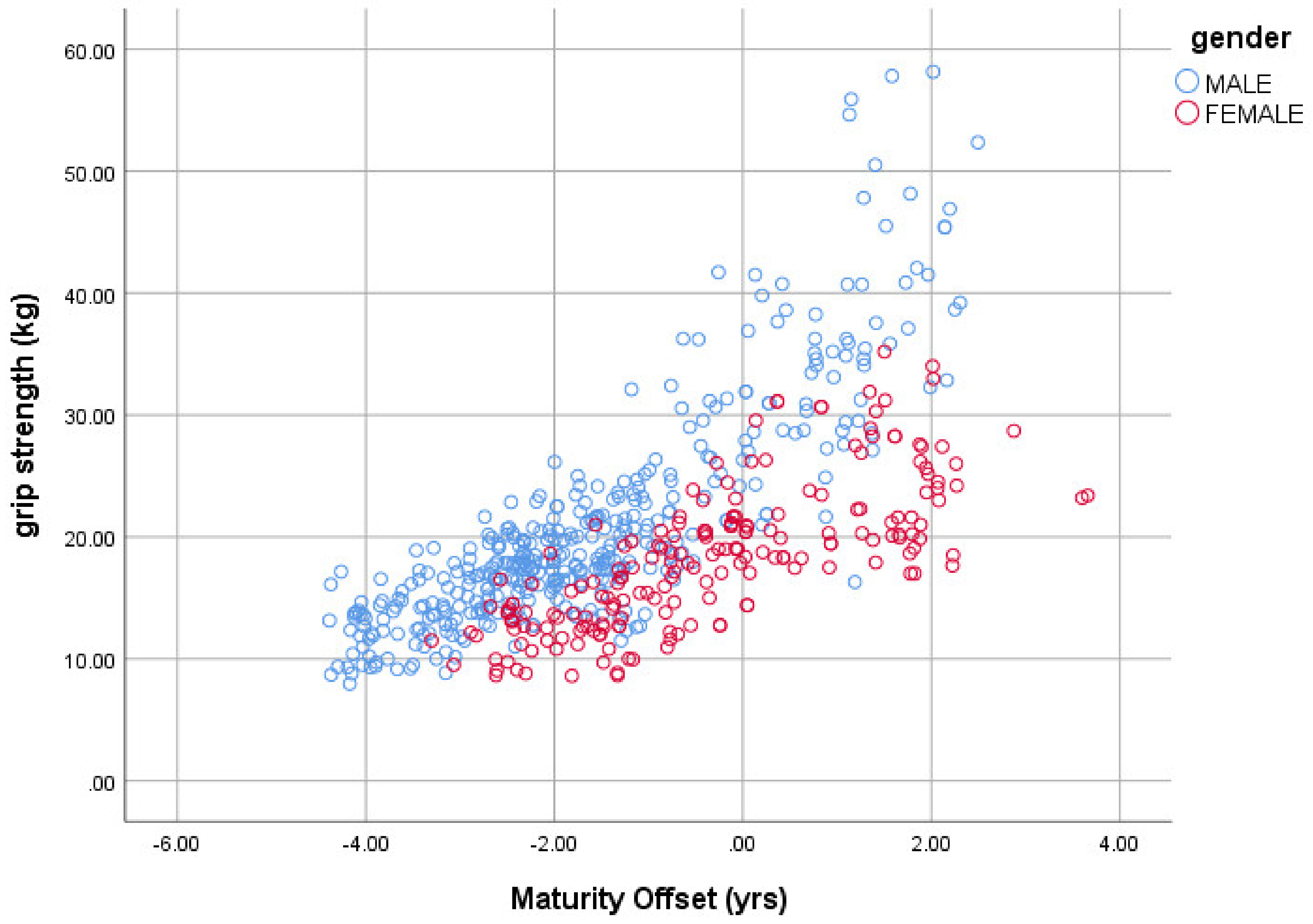
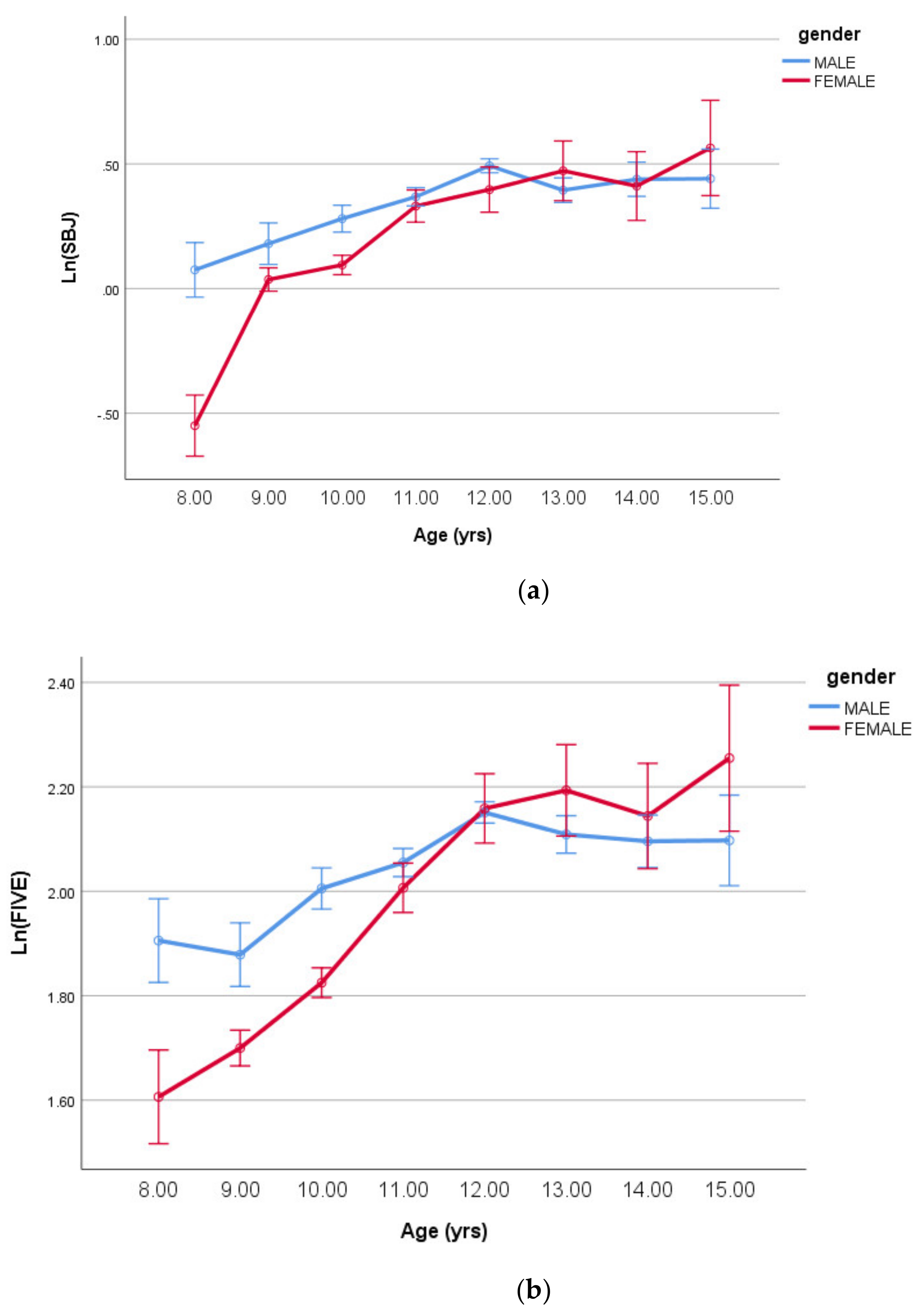
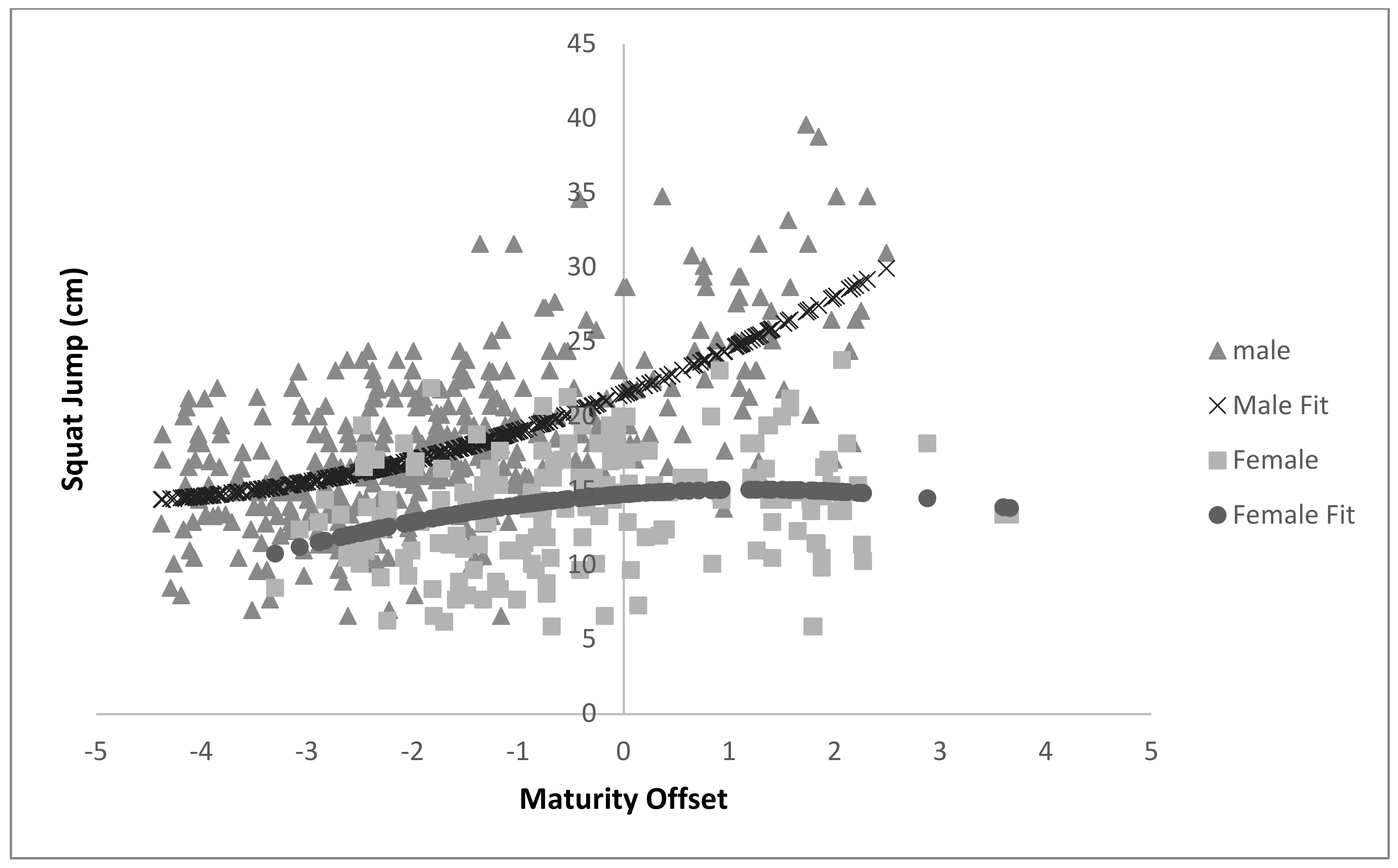
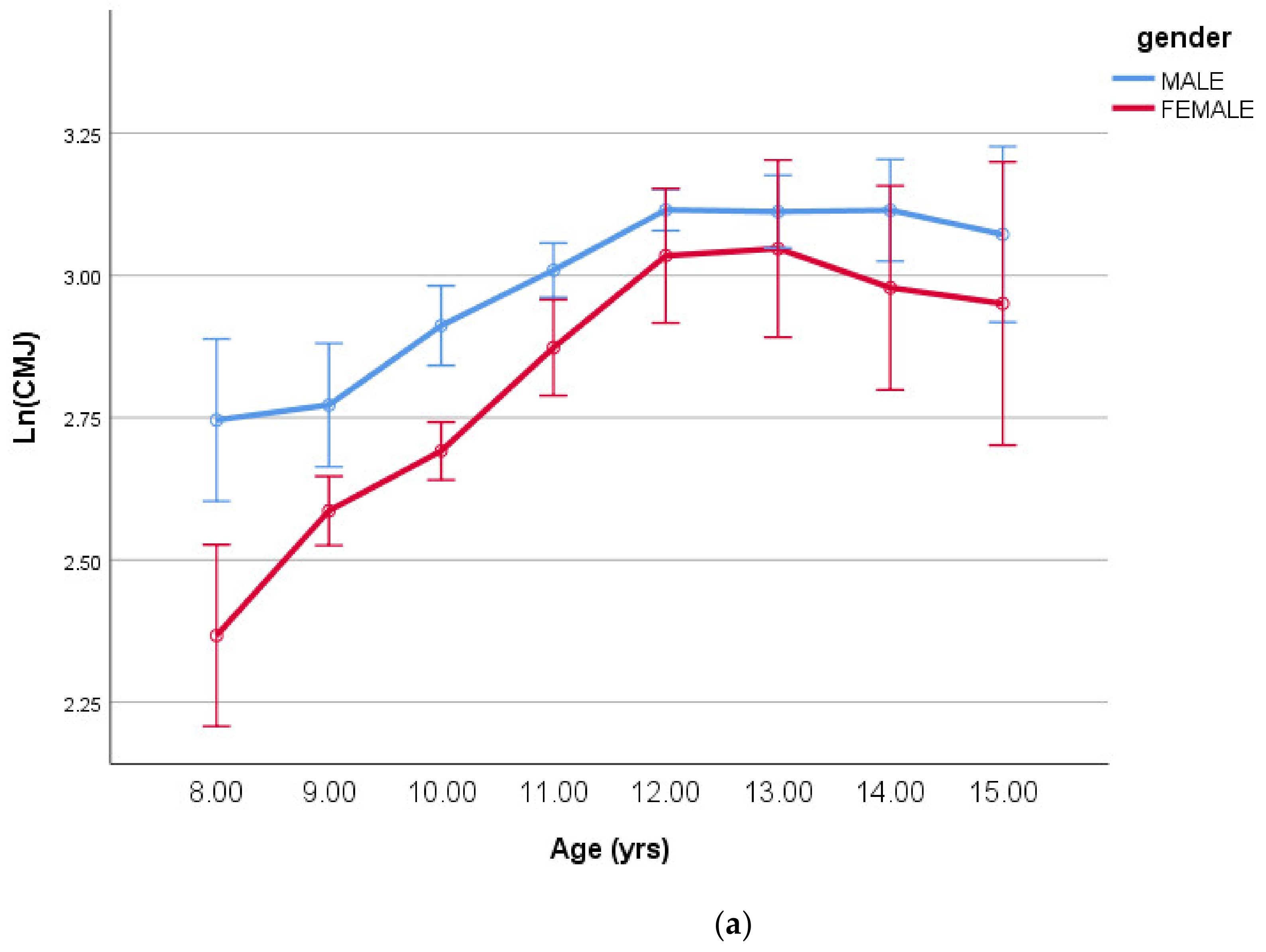
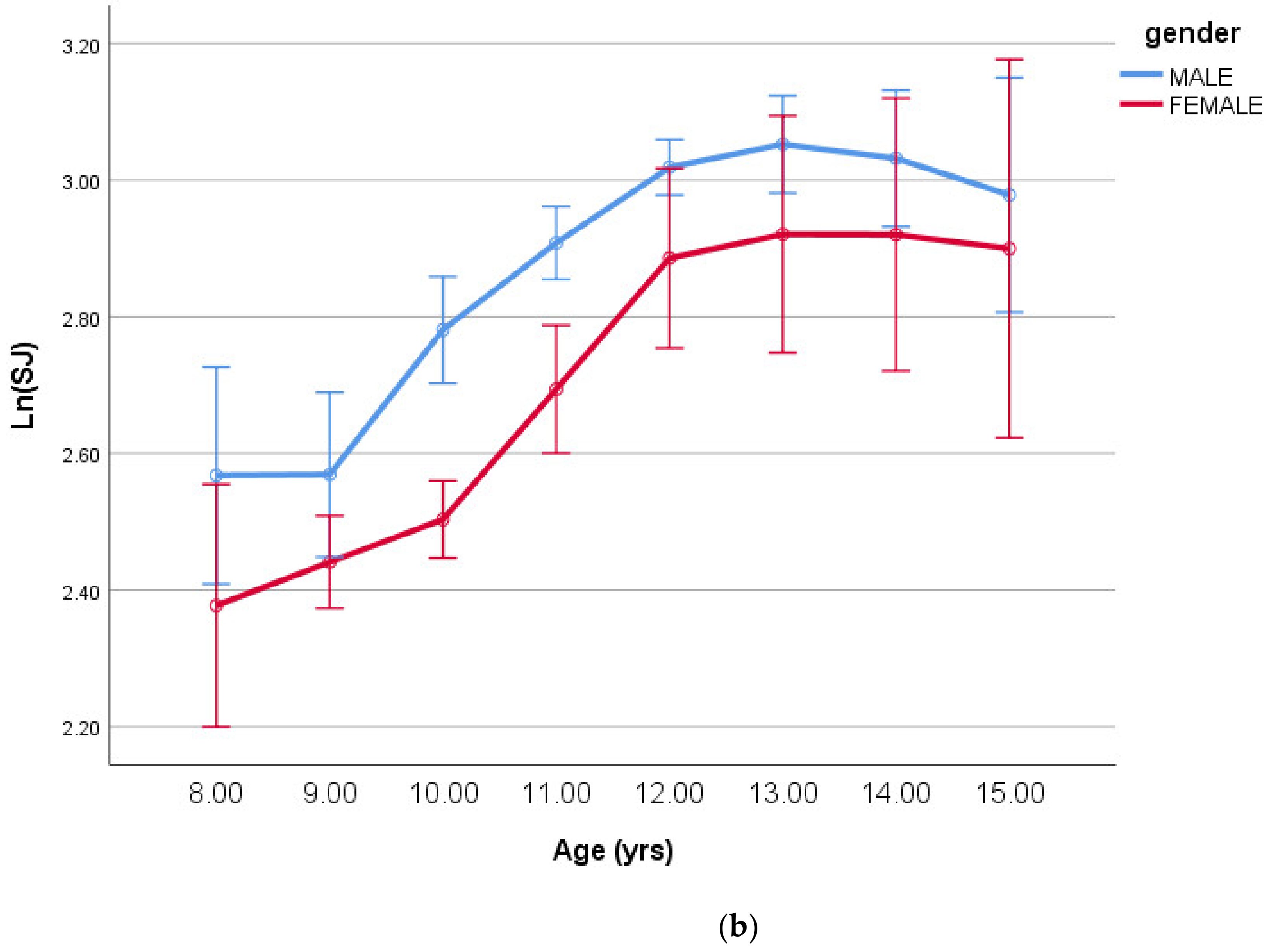
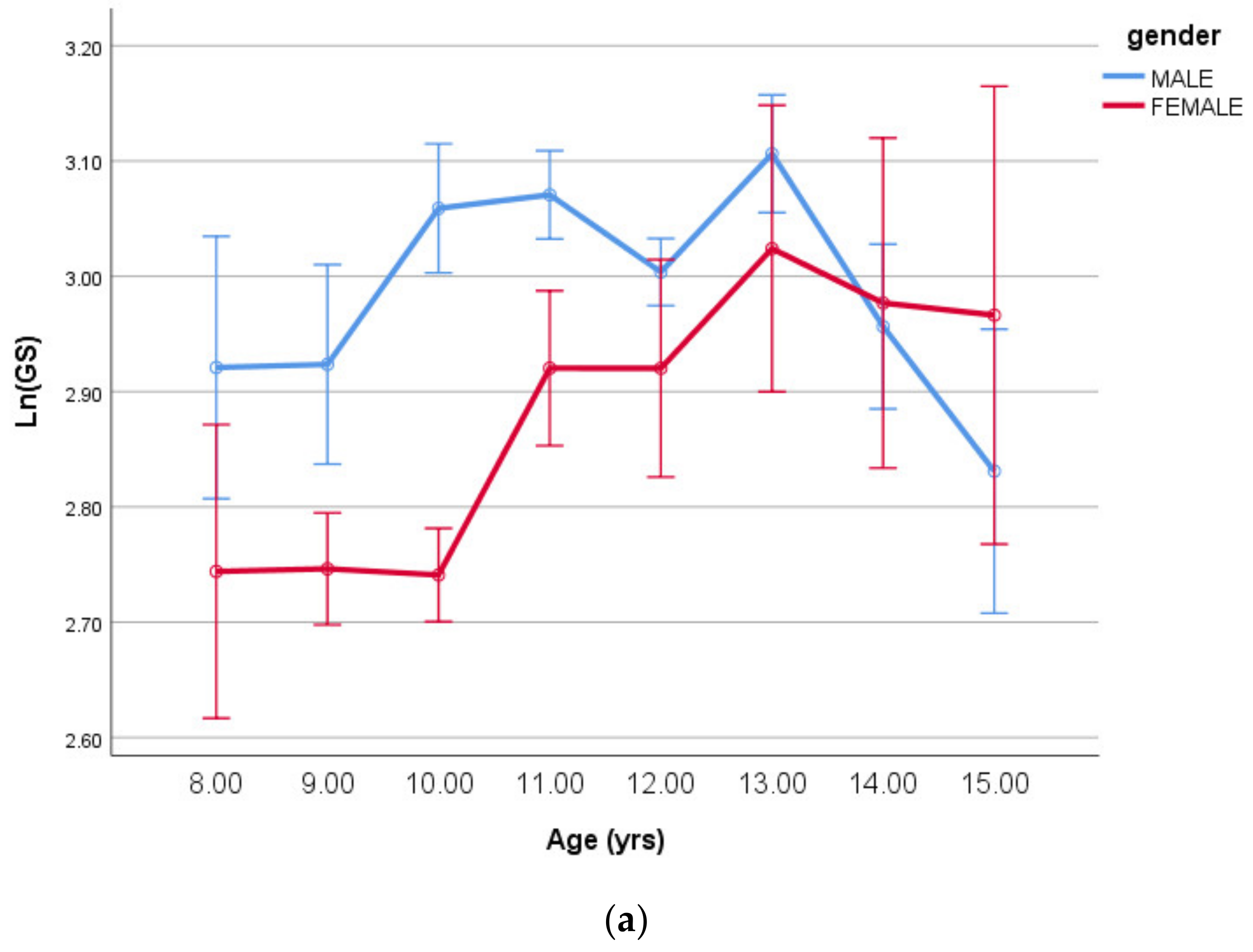
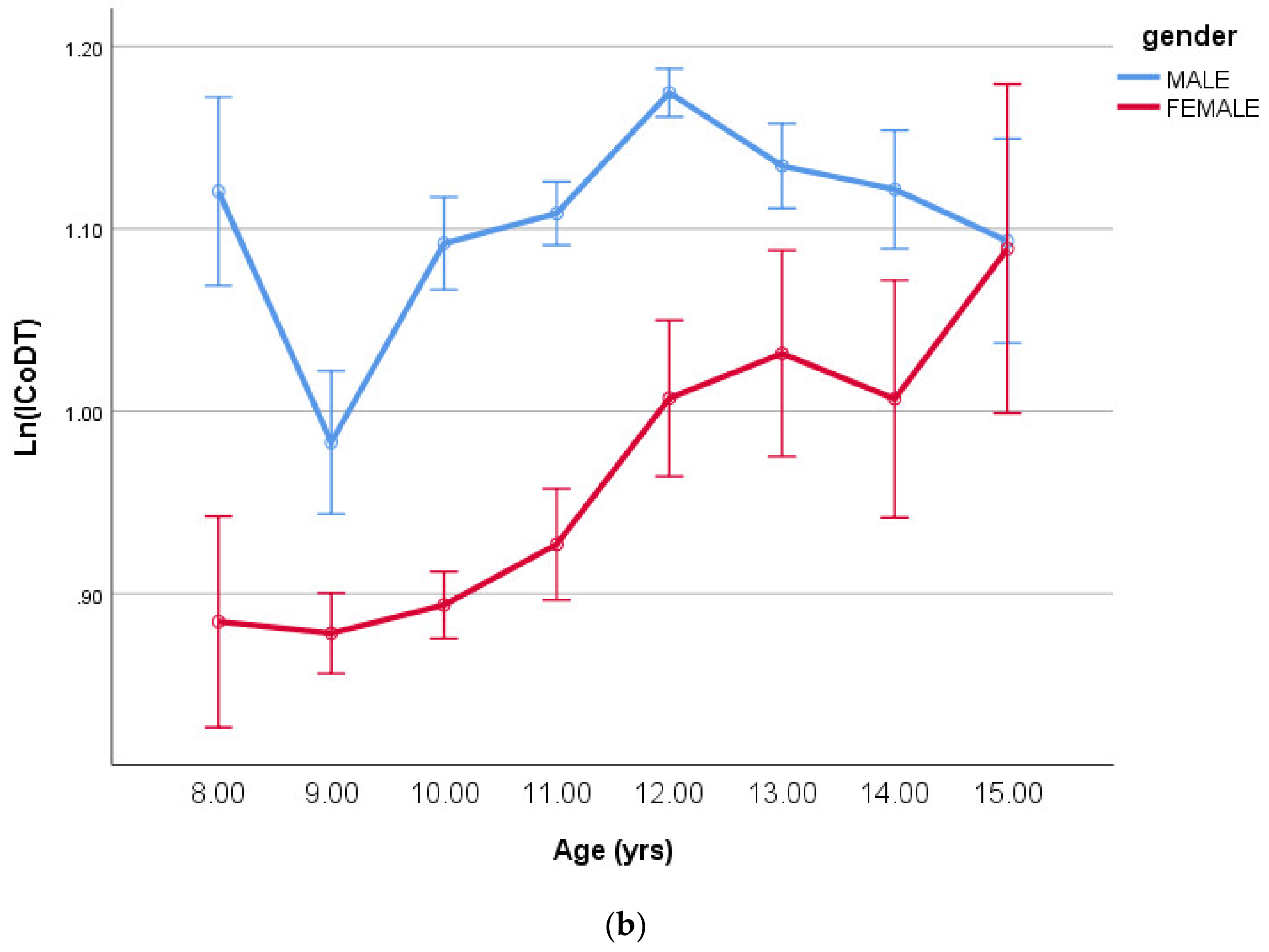
| Boys | |||||||||
|---|---|---|---|---|---|---|---|---|---|
| Age | N | Body Mass (kg) | SD | Height (cm) | SD | BMI (kg·m−2) | SD | MO (Years) | SD |
| 8 | 45 | 30.64 | 5.6 | 132.01 | 6.34 | 17.49 | 2.26 | −3.93 | 0.27 |
| 9 | 36 | 37.06 | 9.3 | 140.88 | 8.05 | 18.56 | 3.81 | −3.16 | 0.35 |
| 10 | 85 | 37.94 | 8.68 | 143.34 | 5.87 | 18.38 | 3.54 | −2.53 | 0.31 |
| 11 | 75 | 42.24 | 9.65 | 148.31 | 7.12 | 19.07 | 3.39 | −1.85 | 0.35 |
| 12 | 74 | 45.86 | 10.06 | 154.64 | 8.73 | 19.05 | 3.25 | −1.03 | 0.44 |
| 13 | 22 | 49.78 | 15.86 | 161.18 | 9.41 | 18.86 | 4.36 | −0.11 | 0.44 |
| 14 | 44 | 59.66 | 13.87 | 172.01 | 7.36 | 20.01 | 3.84 | 0.96 | 0.42 |
| 15 | 15 | 68.84 | 14.46 | 177.61 | 4.91 | 21.78 | 4.46 | 1.97 | 0.34 |
| Total | 396 | 43.56 | 13.83 | 150.36 | 14.17 | 18.89 | 3.56 | −1.64 | 1.6 |
| Girls | |||||||||
| 8 | 3 | 29.3 | 3.3 | 128.97 | 4.91 | 17.57 | 0.66 | −3.02 | 0.32 |
| 9 | 32 | 31.18 | 7.79 | 135.48 | 7.46 | 16.88 | 3.13 | −2.30 | 0.35 |
| 10 | 43 | 41.06 | 10.36 | 142.96 | 5.84 | 19.93 | 4.08 | −1.38 | 0.33 |
| 11 | 50 | 46.26 | 12.53 | 150.75 | 6.83 | 20.17 | 4.26 | −0.37 | 0.37 |
| 12 | 27 | 53.54 | 13.01 | 155.5 | 7.09 | 22.15 | 5.42 | 0.49 | 0.46 |
| 13 | 17 | 56.51 | 13.24 | 160.09 | 5.27 | 22.01 | 4.83 | 1.44 | 0.42 |
| 14 | 24 | 52.97 | 16.74 | 157.5 | 2.59 | 21.39 | 6.87 | 1.86 | 0.19 |
| 15 | 5 | 52.74 | 4.61 | 166 | 9.59 | 19.26 | 2.38 | 2.93 | 0.68 |
| Total | 201 | 45.3 | 14.4 | 148.94 | 10.71 | 20.1 | 4.85 | −0.32 | 1.51 |
| Parameter Estimates | ||||||
|---|---|---|---|---|---|---|
| DP = LnSpeed30 | B | SE | t | p | Lower Bound | Upper Bound |
| Intercept | −1.255 | 0.825 | −1.522 | 0.129 | −2.875 | 0.365 |
| Female | 0.119 | 0.084 | 1.406 | 0.160 | −0.047 | 0.285 |
| LnMass | −0.158 | 0.017 | −9.376 | 0.000 | −0.192 | −0.125 |
| LnHT | 0.707 | 0.169 | 4.192 | 0.000 | 0.376 | 1.039 |
| MO | 0.031 | 0.022 | 1.413 | 0.158 | −0.012 | 0.073 |
| MO2 | 0.009 | 0.004 | 2.672 | 0.008 | 0.003 | 0.016 |
| Female * MO | −0.069 | 0.020 | −3.532 | 0.000 | −0.107 | −0.031 |
| Female * MO2 | −0.017 | 0.006 | −2.801 | 0.005 | −0.029 | −0.005 |
| The coefficient of determination R2 = 0.592 (Adj R2 = 0.577); log transformed error ratio being 0.073 or 7.6%, having taken antilogs | ||||||
| DP = LnSpeed20 | ||||||
| Intercept | −0.083 | 0.698 | −0.118 | 0.906 | −1.454 | 1.289 |
| Female | 0.122 | 0.071 | 1.716 | 0.087 | −0.018 | 0.262 |
| LnMass | −0.145 | 0.014 | −10.170 | 0.000 | −0.173 | −0.117 |
| LnHT | 0.452 | 0.143 | 3.166 | 0.002 | 0.172 | 0.733 |
| MO | 0.046 | 0.018 | 2.489 | 0.013 | 0.010 | 0.082 |
| MO2 | 0.008 | 0.003 | 2.533 | 0.012 | 0.002 | 0.013 |
| Female * MO | −0.065 | 0.016 | −3.934 | 0.000 | −0.097 | −0.032 |
| Female * MO2 | −0.018 | 0.005 | −3.494 | 0.001 | −0.028 | −0.008 |
| The coefficient of determination R2 = 0.605 (Adj R2 = 0.591); log transformed error ratio being 0.061 or 6.3%, having taken antilogs | ||||||
| DP = LnSpeed10 | ||||||
| Intercept | 0.362 | 0.698 | 0.519 | 0.604 | −1.009 | 1.733 |
| Female | 0.100 | 0.071 | 1.400 | 0.162 | −0.040 | 0.240 |
| LnMass | −0.144 | 0.014 | −10.041 | 0.000 | −0.172 | −0.116 |
| LnHT | 0.340 | 0.143 | 2.379 | 0.018 | 0.059 | 0.621 |
| MO | 0.045 | 0.018 | 2.460 | 0.014 | 0.009 | 0.081 |
| MO2 | 0.003 | 0.003 | 1.125 | 0.261 | −0.003 | 0.009 |
| Female * MO | −0.066 | 0.016 | −3.990 | 0.000 | −0.098 | −0.033 |
| Female * MO2 | −0.009 | 0.005 | −1.845 | 0.066 | −0.019 | 0.001 |
| Parameter Estimates | ||||||
|---|---|---|---|---|---|---|
| DP = LnSLJ | B | SE | t | p | Lower Bound | Upper Bound |
| Intercept | −5.944 | 1.847 | −3.218 | 0.001 | −9.571 | −2.316 |
| Female | 0.082 | 0.189 | 0.434 | 0.665 | −0.289 | 0.453 |
| LnMass | −0.249 | 0.038 | −6.582 | 0.000 | −0.323 | −0.174 |
| LnHT | 1.451 | 0.378 | 3.839 | 0.000 | 0.709 | 2.193 |
| MO | 0.019 | 0.049 | 0.381 | 0.703 | −0.077 | 0.114 |
| MO2 | 0.017 | 0.008 | 2.137 | 0.033 | 0.001 | 0.033 |
| Female * MO | −0.107 | 0.044 | −2.437 | 0.015 | −0.193 | −0.021 |
| Female * MO2 | −0.020 | 0.013 | −1.501 | 0.134 | −0.046 | 0.006 |
| The coefficient of determination R2 = 0.527 (Adj R2 = 0.510); log transformed error ratio being 0.163 or 17.7%, having taken antilogs | ||||||
| DP = LnFIVE | ||||||
| Intercept | −3.645 | 1.352 | −2.695 | 0.007 | −6.301 | −0.989 |
| Female | 0.064 | 0.138 | 0.461 | 0.645 | −0.208 | 0.336 |
| LnMass | −0.155 | 0.028 | −5.598 | 0.000 | −0.209 | −0.100 |
| LnHT | 1.261 | 0.277 | 4.558 | 0.000 | 0.718 | 1.805 |
| MO | 0.028 | 0.036 | 0.798 | 0.425 | −0.042 | 0.098 |
| MO2 | 0.010 | 0.006 | 1.669 | 0.096 | −0.002 | 0.021 |
| Female * MO | −0.103 | 0.032 | −3.200 | 0.001 | −0.166 | −0.040 |
| Female * MO2 | −0.007 | 0.010 | −0.692 | 0.489 | −0.026 | 0.012 |
| Parameter Estimates | ||||||
|---|---|---|---|---|---|---|
| DP = LnCMJ | B | SE | t | p | Lower Bound | Upper Bound |
| Intercept | −2.349 | 2.406 | −0.976 | 0.329 | −7.075 | 2.377 |
| Female | −0.205 | 0.246 | −0.833 | 0.405 | −0.689 | 0.279 |
| LnMass | −0.466 | 0.049 | −9.478 | 0.000 | −0.563 | −0.370 |
| LnHT | 1.429 | 0.492 | 2.901 | 0.004 | 0.462 | 2.396 |
| MO | 0.090 | 0.063 | 1.427 | 0.154 | −0.034 | 0.215 |
| MO2 | 0.029 | 0.010 | 2.764 | 0.006 | 0.008 | 0.049 |
| Female * MO | −0.155 | 0.057 | −2.708 | 0.007 | −0.267 | −0.042 |
| Female * MO2 | −0.024 | 0.017 | −1.351 | 0.177 | −0.058 | 0.011 |
| The coefficient of determination R2 = 0.487 (Adj R2 = 0.468) with the log transformed error ratio being 0.212 or 23.7%, having taken antilogs | ||||||
| DP = LnSJ | ||||||
| Intercept | −3.706 | 2.677 | −1.384 | 0.167 | −8.965 | 1.553 |
| Female | −0.084 | 0.274 | −0.305 | 0.761 | −0.622 | 0.455 |
| LnMass | −0.505 | 0.055 | −9.225 | 0.000 | −0.613 | −0.398 |
| LnHT | 1.702 | 0.548 | 3.107 | 0.002 | 0.626 | 2.778 |
| MO | 0.081 | 0.070 | 1.149 | 0.251 | −0.057 | 0.219 |
| MO2 | 0.035 | 0.012 | 3.027 | 0.003 | 0.012 | 0.057 |
| Female * MO | −0.165 | 0.064 | −2.600 | 0.010 | −0.290 | −0.040 |
| Female * MO2 | −0.045 | 0.019 | −2.307 | 0.021 | −0.083 | −0.007 |
| Parameter Estimates | ||||||
|---|---|---|---|---|---|---|
| DV = LnGS | B | SE | T | p | Lower Bound | Upper Bound |
| Intercept | −4.790 | 1.920 | −2.495 | 0.013 | −8.560 | −1.019 |
| Female | 0.036 | 0.197 | 0.186 | 0.853 | −0.350 | 0.423 |
| LnMass | 0.378 | 0.039 | 9.617 | 0.000 | 0.300 | 0.455 |
| LnHT | 1.254 | 0.393 | 3.193 | 0.001 | 0.483 | 2.026 |
| MO | 0.149 | 0.050 | 2.948 | 0.003 | 0.050 | 0.248 |
| MO2 | 0.025 | 0.008 | 3.025 | 0.003 | 0.009 | 0.041 |
| Female * MO | −0.147 | 0.046 | −3.235 | 0.001 | −0.237 | −0.058 |
| Female * MO2 | −0.018 | 0.014 | −1.294 | 0.196 | −0.045 | 0.009 |
| The coefficient of determination, R2 = 0.793 (Adj R2 = 0.786) with the log transformed error ratio being 0.169 or 18.5%, having taken antilogs | ||||||
| DV = LnICoDT | ||||||
| Intercept | 0.489 | 0.871 | 0.561 | 0.575 | −1.223 | 2.200 |
| Female | 0.023 | 0.089 | 0.263 | 0.792 | −0.152 | 0.199 |
| LnMass | −0.107 | 0.018 | −5.984 | 0.000 | −0.142 | −0.072 |
| LnHT | 0.207 | 0.178 | 1.162 | 0.246 | −0.143 | 0.558 |
| MO | 0.037 | 0.023 | 1.616 | 0.107 | −0.008 | 0.082 |
| MO2 | 0.002 | 0.004 | 0.642 | 0.521 | −0.005 | 0.010 |
| Female * MO | −0.024 | 0.021 | −1.155 | 0.249 | −0.064 | 0.017 |
| Female * MO2 | −0.013 | 0.006 | −2.071 | 0.039 | −0.026 | −0.001 |
Publisher’s Note: MDPI stays neutral with regard to jurisdictional claims in published maps and institutional affiliations. |
© 2021 by the authors. Licensee MDPI, Basel, Switzerland. This article is an open access article distributed under the terms and conditions of the Creative Commons Attribution (CC BY) license (http://creativecommons.org/licenses/by/4.0/).
Share and Cite
Nevill, A.M.; Negra, Y.; Myers, T.D.; Duncan, M.J.; Chaabene, H.; Granacher, U. Are Early or Late Maturers Likely to Be Fitter in the General Population? Int. J. Environ. Res. Public Health 2021, 18, 497. https://doi.org/10.3390/ijerph18020497
Nevill AM, Negra Y, Myers TD, Duncan MJ, Chaabene H, Granacher U. Are Early or Late Maturers Likely to Be Fitter in the General Population? International Journal of Environmental Research and Public Health. 2021; 18(2):497. https://doi.org/10.3390/ijerph18020497
Chicago/Turabian StyleNevill, Alan M., Yassine Negra, Tony D. Myers, Michael J. Duncan, Helmi Chaabene, and Urs Granacher. 2021. "Are Early or Late Maturers Likely to Be Fitter in the General Population?" International Journal of Environmental Research and Public Health 18, no. 2: 497. https://doi.org/10.3390/ijerph18020497
APA StyleNevill, A. M., Negra, Y., Myers, T. D., Duncan, M. J., Chaabene, H., & Granacher, U. (2021). Are Early or Late Maturers Likely to Be Fitter in the General Population? International Journal of Environmental Research and Public Health, 18(2), 497. https://doi.org/10.3390/ijerph18020497









